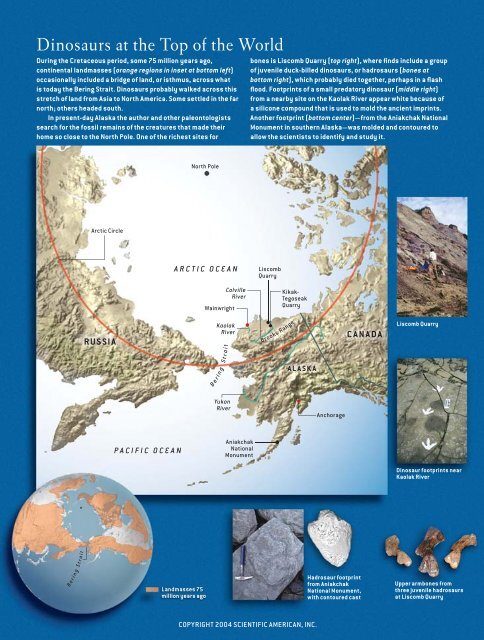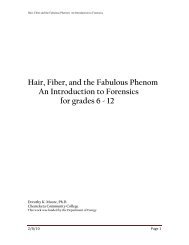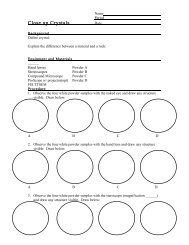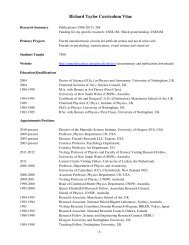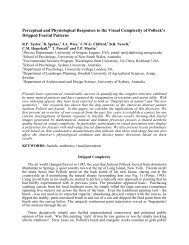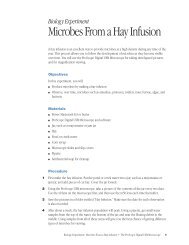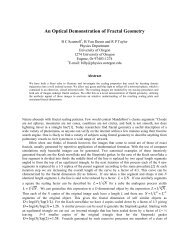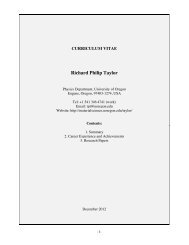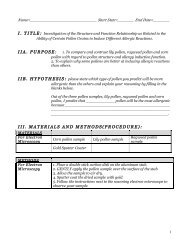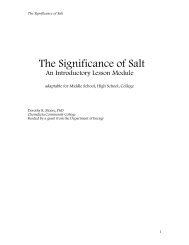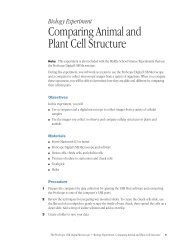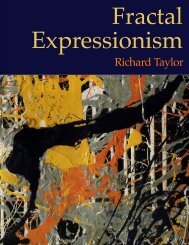December 2004 - Materials Science Institute - University of Oregon
December 2004 - Materials Science Institute - University of Oregon
December 2004 - Materials Science Institute - University of Oregon
Create successful ePaper yourself
Turn your PDF publications into a flip-book with our unique Google optimized e-Paper software.
Dinosaurs at the Top <strong>of</strong> the World<br />
During the Cretaceous period, some 75 million years ago,<br />
continental landmasses (orange regions in inset at bottom left)<br />
occasionally included a bridge <strong>of</strong> land, or isthmus, across what<br />
is today the Bering Strait. Dinosaurs probably walked across this<br />
stretch <strong>of</strong> land from Asia to North America. Some settled in the far<br />
north; others headed south.<br />
In present-day Alaska the author and other paleontologists<br />
search for the fossil remains <strong>of</strong> the creatures that made their<br />
home so close to the North Pole. One <strong>of</strong> the richest sites for<br />
B e r i n g S t r a i t<br />
Arctic Circle<br />
RUSSIA<br />
PACIFIC OCEAN<br />
North Pole<br />
ARCTIC OCEAN<br />
Landmasses 75<br />
million years ago<br />
Wainwright<br />
B e r i n g S t r a i t<br />
Colville<br />
River<br />
Kaolak<br />
River<br />
Yukon<br />
River<br />
Aniakchak<br />
National<br />
Monument<br />
bones is Liscomb Quarry (top right), where fi nds include a group<br />
<strong>of</strong> juvenile duck-billed dinosaurs, or hadrosaurs (bones at<br />
bottom right), which probably died together, perhaps in a fl ash<br />
fl ood. Footprints <strong>of</strong> a small predatory dinosaur (middle right)<br />
from a nearby site on the Kaolak River appear white because <strong>of</strong><br />
a silicone compound that is used to mold the ancient imprints.<br />
Another footprint (bottom center)—from the Aniakchak National<br />
Monument in southern Alaska—was molded and contoured to<br />
allow the scientists to identify and study it.<br />
Liscomb<br />
Quarry<br />
Kikak-<br />
Tegoseak<br />
Quarry<br />
Brooks Range<br />
ALASKA<br />
COPYRIGHT <strong>2004</strong> SCIENTIFIC AMERICAN, INC.<br />
Anchorage<br />
Hadrosaur footprint<br />
from Aniakchak<br />
National Monument,<br />
with contoured cast<br />
CANADA<br />
Liscomb Quarry<br />
Dinosaur footprints near<br />
Kaolak River<br />
Upper armbones from<br />
three juvenile hadrosaurs<br />
at Liscomb Quarry<br />
CREDIT


